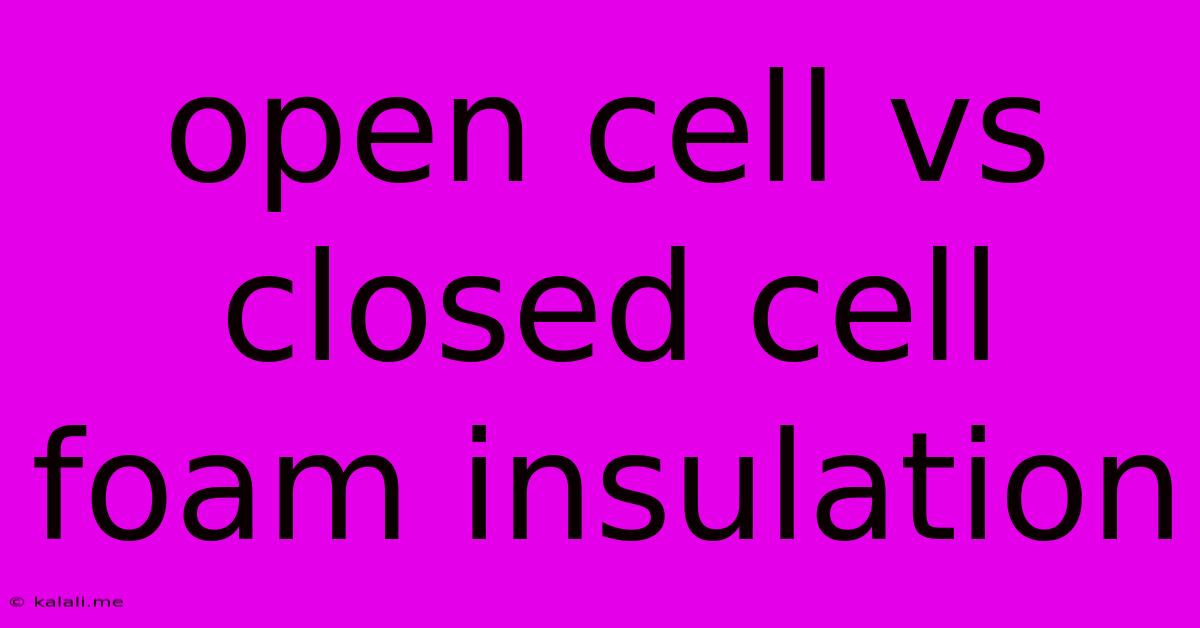Open Cell Vs Closed Cell Foam Insulation
Kalali
May 28, 2025 · 3 min read

Table of Contents
Open Cell vs. Closed Cell Foam Insulation: Which is Right for You?
Choosing the right insulation for your home is a crucial decision impacting energy efficiency, comfort, and long-term cost savings. Two popular options vying for your attention are open-cell and closed-cell spray foam insulation. Both offer excellent thermal performance, but their distinct properties make them suitable for different applications and climates. This article dives deep into the differences between open-cell and closed-cell foam insulation, helping you make an informed choice for your specific needs.
What are the Key Differences Between Open-Cell and Closed-Cell Foam Insulation?
The primary difference lies in their cell structure. Open-cell foam has interconnected cells, creating a more porous structure. Closed-cell foam, conversely, features individual, sealed cells. This fundamental difference leads to variations in their performance characteristics.
Key Characteristics Comparison:
| Feature | Open-Cell Foam | Closed-Cell Foam |
|---|---|---|
| Cell Structure | Interconnected cells | Individual, sealed cells |
| Density | Lower density | Higher density |
| R-Value | Lower R-value per inch (typically 3.5-3.7) | Higher R-value per inch (typically 6-7) |
| Water Resistance | Less water resistant | Highly water resistant |
| Air Sealing | Excellent air sealant | Excellent air sealant |
| Moisture Vapor Permeability | More permeable | Less permeable |
| Cost | Generally less expensive | Generally more expensive |
| Installation | Easier and faster installation | More challenging installation |
| Durability | Less durable, prone to settling over time | More durable, resistant to settling |
| Sound Dampening | Good sound dampening | Excellent sound dampening |
Open-Cell Foam Insulation: Pros and Cons
Pros:
- Higher thermal performance per dollar: Open-cell foam offers a good balance between R-value and cost.
- Better moisture vapor permeability: This can be beneficial in certain climates, preventing moisture buildup.
- Easier and faster installation: Leading to potentially lower labor costs.
- Excellent air sealing: Significantly reduces air infiltration, improving energy efficiency.
Cons:
- Lower R-value: Requires a thicker application to achieve the same insulation level as closed-cell foam.
- Less water resistant: Susceptible to water damage if exposed to moisture.
- Less durable: Prone to settling and compression over time.
Closed-Cell Foam Insulation: Pros and Cons
Pros:
- Higher R-value: Provides superior thermal performance with less thickness.
- Excellent water resistance: Offers superior protection against moisture intrusion.
- Higher structural integrity: Acts as a structural component, increasing building strength.
- Superior sound dampening: Blocks more noise than open-cell foam.
- Longer lifespan: More durable and less prone to settling.
Cons:
- Higher cost: Both material and labor costs are typically higher.
- More challenging installation: Requires specialized equipment and expertise.
- Less moisture vapor permeable: Can potentially trap moisture if not properly installed in humid climates.
Choosing the Right Foam Insulation: Factors to Consider
The best choice depends on several factors:
- Climate: In humid climates, closed-cell foam's superior water resistance is highly advantageous. In drier climates, the cost-effectiveness of open-cell foam might be preferable.
- Budget: Open-cell foam is generally more budget-friendly.
- R-value requirements: If high R-value is crucial, closed-cell foam is the better option.
- Structural needs: If you need added structural strength, closed-cell foam provides this benefit.
- Moisture management: Consider your climate and the building's ventilation system when assessing moisture vapor permeability.
Ultimately, consulting with a qualified insulation professional is recommended. They can assess your specific needs, evaluate your home's characteristics, and recommend the optimal insulation solution for optimal energy efficiency and long-term value. They can also address any concerns about potential problems with moisture, and can perform a proper installation. Don't hesitate to ask questions and compare quotes before making your decision.
Latest Posts
Latest Posts
-
How Far Can I Span A 2x6 Rafter
May 29, 2025
-
If You Would Be Able To Do So
May 29, 2025
-
Found Input Variables With Inconsistent Numbers Of Samples
May 29, 2025
-
How Tall Is A Lego Brick
May 29, 2025
-
How Many Words Are In A Chapter
May 29, 2025
Related Post
Thank you for visiting our website which covers about Open Cell Vs Closed Cell Foam Insulation . We hope the information provided has been useful to you. Feel free to contact us if you have any questions or need further assistance. See you next time and don't miss to bookmark.